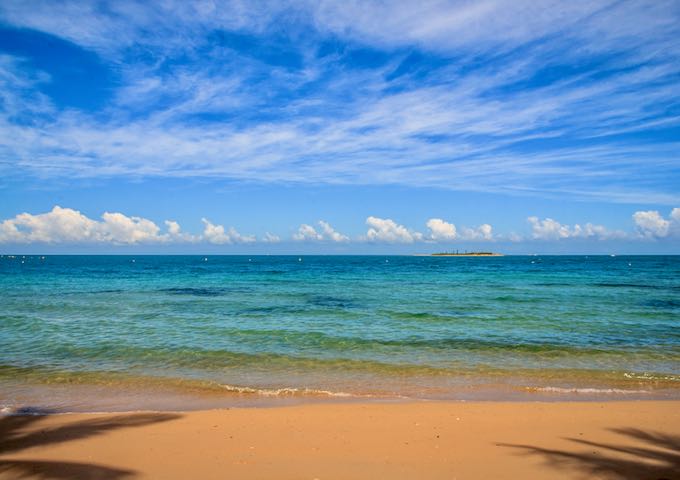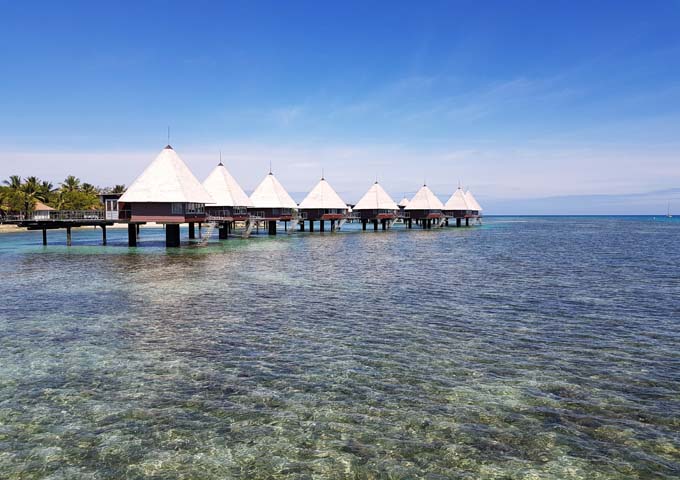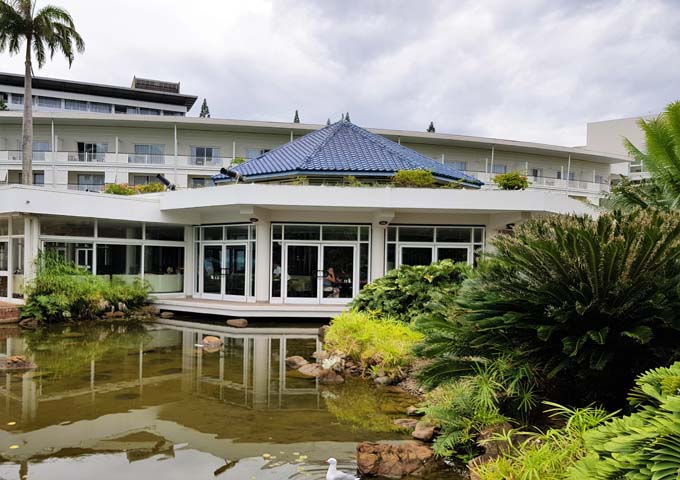SD › Where to Stay in New Caledonia
Updated: September 12, 2020
By Santorini Dave
Best Places to Stay in New Caledonia

The best area for first time visitors to New Caledonia: Anse Vata. (Just outside of the capital, Noumea.)
On the southern fringe of Melanesia, New Caledonia is still a territory of France, but only a few hours by plane from Australia and New Zealand. Sometimes spelt New-Caledonia, and translated as Nouvelle Calédonie, the territory is substantially French in history, food, and language. Receiving substantial funding from Paris, and containing vast deposits of nickel, some tourists are pleasantly surprised at how modern and westernized it is – especially after visiting Fiji, Tonga or Vanuatu. Roads are plentiful, well-paved, and rarely affected by weather, and bus services are reliable and comfortable. But this all comes at a cost, of course: exchange rates are set to the Euro, and prices are high – in some cases, more expensive than France itself.
New Caledonia offers the usual attractions of a Pacific paradise: divine beaches, lush landscapes, and traditional villages. But it also boasts a 1,600km reef (the world’s largest after the Great Barrier Reef in Australia); and a lagoon that is definitely the world’s biggest, and arguably the most extraordinary. And the tourism industry is pleasingly developed (as much for residents as tourists), with outstanding opportunities for adventure such as diving, hiking, mountain-biking, and water-sports rarely found elsewhere in Melanesia.
Literally meaning Big Land, Grande Terre is where almost all residents live, and most tourists visit. It’s about 400km long, but only an average of 60km wide, with a mountain range between coasts peaking at about 1,600m. The capital, Noumea, and its sprawling suburbs are home to about 170,000 inhabitants, representing about two-thirds of the territory’s population, mostly of French background. With colonial-era buildings, middle-class suburbs, and scruffy dockyards, there are enough museums, markets, and churches in the city center to potter about, but most visitors stay around the world-class beaches in the suburbs of Anse Vata and Baie des Citrons.
Dangling off the south coast of Grande Terre is Île des Pins (Island of Pines), also known by residents as Kunié. With lagoons of turquoise waters, coral cliffs, and of course, pines outnumbering palms, it’s hugely popular as a romantic getaway. The only other islands of note are the 3 atolls of sandy beaches, deep bays, and remarkable cliffs making up the Loyalty Islands: Maré, Lifou and Ouvéa.
The indigenous Kanak people are pervasive in the city, towns and villages, with traditional customs proudly continuing in more remote areas. First ‘discovered’ by the British more than 2 centuries ago, but administered by the French since 1853, New Caledonia has had a troubled past, and possibly faces an uncertain future. By mid-2018, the populace was still preparing for an imminent referendum about independence, not helped by ongoing arguments about whether the recently-settled French should be able to vote.
The Best Places To Stay in New Caledonia

L’Escapade Îlot Maître on Îlot Maître island.
- Best Luxury Hotels in New Caledonia
Le Méridien Noumea Resort & Spa • Château Royal Beach Resort & Spa • L’Escapade Îlot Maître - Best Boutique Hotels in New Caledonia
Hôtel Le Lagon • Gondwana Hotel - Best Budget Hotels in New Caledonia
Residence Marina Beach • Hotel Beaurivage
- Best Region for Beaches: Maré (Loyalty Islands)
Hard to narrow down just 1, but perhaps la crème de la crème is Maré Island. Along the southern bay, Wabao ticks all the boxes: an extended streak of snow-white sands with calm, shallow, and baby-blue waters overflowing with colorful fish seemingly within touching distance of the shore. Most beaches around Maré are only accessible on foot, ensuring they remain remarkably undeveloped, and often completely deserted. One of the more accessible is Ekure, at the end of an easy hiking trail; more remote and Crusoe-esque is the beach at Buhnetine. As well as clusters of thatched bungalows, local tourist authorities promote the chance to stay at a ‘tribal homestay’. - Best Region for Diving & Snorkeling: Ouvéa (Loyalty Islands)
Despite boasting the world’s biggest lagoon and second-largest reef (which more-or-less surrounds New Caledonia), diving is not as developed or popular as Fiji or Vanuatu. This is probably because there is so much more to do across the entire territory. Part of the Loyalty Islands, Ouvéa vies with Maré as the perfect beach destination, but is also fantastic for underwater exploration. The lagoon is exquisite, dotted with islets, and backed by coral cliffs. Diving is easy to arrange among caves and reefs, but there’s also plenty to see with just a snorkel and mask. What’s more, a bit of time and effort will reward hikers/snorkelers with freshwater pools teeming with turtles. - Best Region for Outdoor Activities: Province Sud (South Province) of Grande Terre Island
An extraordinary array of activities is available within a short bus ride (or even daytrip) from the capital. Not cheap compared to Fiji or Tonga, they are nonetheless, well-developed and safe – as much for locals (especially French expats) as tourists. These include hiking among rainforests sprinkled with waterfalls along well-defined trails that can also be traversed by mountain-bike; kayaking among eerie forests of dead trees; exploring national parks brimming with rare and endemic birds; and whale-watching (July to September) along the southeast coast. - Best Region for Boating: Baie de la Moselle (centre of Noumea)
Yachties don’t need to berth anywhere remote or potentially unsafe because Noumea is encircled by marinas heaving with boats of all types, mostly owned by affluent locals. The most convenient is at Baie de la Moselle, which is deep, calm, secure, and within strolling distance of numerous facilities. Easy trips by boat from Noumea include the idyllic Île des Pins island about 3 hours away, and gorgeous islets such as Île aux Canards and Îlot Maître are within just a few minutes of the marina. And while sipping lattes or swigging beers in the city’s trendy cafés, fellow yachties happily share advice about sailing up the extended coasts of Grande Terre and across to the magical Loyalty Islands. - Best Region for Shopping: Noumea
Fashionable, with plenty of well-heeled residents and affluent French visitors, Noumea is sprinkled with classy boutiques selling imported designer label goods at prices to match Paris. And as a major city, several sizeable malls with more affordable shops can be found. Surprising is the extensive Moselle Markets, open from 5am to mid-day every day (except Monday), which offers a wonderful array of fruit, vegetables, flowers, and fish. Also for sale are those tasty pastries the French are so fond of, and clothes and traditional handicrafts. And a vast fascinating flea market is held on Sundays twice a month at the main city park, Place des Cocotiers. - Best Region for Food & Restaurants: Baie des Citrons (Noumea)
The middle-class suburbs stretch south for several kilometers from the city center to the beach-side suburbs of Anse Vata and Baie des Citrons. The latter is pleasingly under-developed, with much more of the esplanade lined with chic bistros than upmarket resorts. And the extraordinary choice reflects the multiculturalism of the territory, with cafés offering Vietnamese, Chinese, Italian, Japanese, and of course, French cuisine. But be warned: prices often match those expected in France because of European-level wages, and so much needs to be imported. - Best Region for Families: Anse Vata (Noumea)
Of the 2 beach-side suburbs less than 15 minutes by bus from downtown Noumea, Anse Vata offers a lovable tropical-island beach vibe. The calm lagoon waters are safe for swimming, and ideal for kayaking and snorkeling, and the beach is broad, clean and sandy. Facilities around Anse Vata include arcades lined with fascinating shops, oodles of eateries and bakeries, and supermarkets (important if self-catering). What’s more, the alluring islets just offshore are easy to reach by boat, and the fun tchou tchou train putters around the esplanade and backstreets. Several family-friendly resorts offer a children’s pool, activities for the younger ones, and packaged deals, while numerous travel agencies, and the helpful tourist office, can assist with exploration of the island. And Anse Vata is only about 45 minutes from the international airport. - Best Region for Nightlife: Center of Noumea
Not surprisingly, most of the things to do after dark are in the capital. Eclectic choices in the city center include dinner at a chic bistro around the Latin Quarter or Chinatown; chatting to yachties at a fashionable pub along 1 of the marinas; catching a cabaret or musical show; or rolling the dice at 1 of the casinos. Families may prefer watching a movie at Cinecity, or attending 1 of the numerous festivals (most often in the dry season, May to October). And by 10pm, the younger set will be ready to hit the hippest new nightclubs. - Best Region for Vibe & Culture: La Fao
As expected, the further away from Noumea the better the opportunity to meet authentic Kanak people who live in traditional villages and practice tribal customs. But it is still possible to experience Kanak culture at La Fao, only 110km from the capital. Steeped in history, the likeable town is now a hangout for arty expats, a regional center for farmers, and a gateway to several national parks. The Kanak culture and genuine Caledonian Cowboy vibe can be experienced at the Saturday markets, nearby villages like Sarraméa, home to 3 tribes, and Farino, perched in the mountains. - Best Region for a Romantic Holiday: Îles des Pins Island
Dangling off the southern coast of Grand Terre, it’s hard to imagine a more dreamy location, with turquoise lagoons so precious they’re protected by UNESCO, snow-white beaches dotted with sloping palms, and of course, the namesake pines. Add coral islets jutting into the waters and only accessible by traditional outrigger canoes, amiable villages that are still deeply conservative, substantial historical ruins and vanilla plantations to wander about, and jaw-dropping hilltop views. Firmly tapping into the honeymoon market, there are family-run and traditional-style bungalows meters from the sand, and 5-star resorts offering luxury and intimacy.
The Best Regions in New Caledonia for Tourists

The best luxury hotel in New Caledonia: Le Méridien Noumea Resort & Spa in Anse Vata.
Noumea – City Center
The capital retains a Melanesian nuance, but mostly resembles a seaside town in France. Downtown is home to various marinas packed with bobbing boats, and there are enough museums, churches, markets, and gardens to keep visitors happy for a day or 2. There aren’t too many hotels, but plenty of boutiques and bistros. Parts are downright scruffy, especially around the dockyards, with massive naval ships just offshore, and abandoned shopping areas. The city center is certainly worth visiting, but staying? Most visitors decide instead to base themselves at 1 of the 2 suburban beaches.
- Best Hotel: Gondwana Hotel
Noumea – Beaches
Unique among capital cities around the South Pacific, the suburbs of Noumea spread south along the coast and finish at two excellent beaches: Baie des Citrons (Bay of Lemons) and Anse Vata. Both are typical tourist regions with multi-star resorts, chic boutiques, elegant bistros, and numerous things to do. These include a shuttle train that traverses the streets, and boat trips to idyllic islets seen from the beaches: the uninhabited Amédéé, dominated by a lighthouse; Île aux Canards (Duck Island); and Îlot Maître (commandeered by the L’Escapade Îlot Maître resort). Yet both beaches are only 10 to 15 minutes by public bus from the city center.
Around Grand Terre Island
Province Nord (North Province)
This is real Cowboy Country, where boussards (bushmen) ride horses across vast plains. There are mountains, rainforests, waterfalls, freshwater springs, and tribal villages that practice customs from centuries ago, but some of the farmland and pristine landscape have been scarred by the nickel mines that keep the country afloat. Along the rugged northwest coast are 2 interesting and accessible towns with accommodation: Koné, the provincial capital; and Koumac, a mining town with a popular marina. The more appealing northeast coast offers meandering rivers, scenic coves of empty beaches, and amiable villages, with amenities and accommodation at Poindimié and Hienghène.
- Best Hotel: Hotel Hibiscus (Koné)
Province Sud (South Province)
The southern half of the main island is more developed than the north because of its proximity to Noumea and the airport, but the terrain does become wilder, and the villages less populated further south. Within a daytrip of the capital, numerous charming towns offer traditional Kanak culture; a rural ambience with bushmen stocking up on supplies or selling produce; colonial-era architecture; and the sort of facilities expected in rural France. The historic town of La Foa boasts an artistic flavour, and is the departure point for exploration of national parks, while other popular stop-offs and bases providing accommodation include Bourail, Sarraméa, and Farino (in the mountains). And the region offers an astonishing array of adventure activities.
- Best Hotel: Hotel Evasion (Sarraméa)
Île des Pins
Administratively part of the southern province of Grande Terre, the Island of Pines seems a world away. Surrounded by an exquisite lagoon, with tranquil, shallow, and turquoise waters lined with bleached-white sands, it’s known to locals as Kunié. It also offers swimming and snorkeling in crystal-clear springs; enchanting colonial-era buildings (including ruins from a previous life as a penal colony); and canoe trips among remarkable coral rocks. And the island is justifiably popular among honeymooners and those seeking the quintessential romantic getaway. Barely 20 minutes by air, or 3 hours by boat from Noumea, most facilities and accommodation are around Kuto rather than the administrative center of Vao.
- Best Hotel: Le Méridien Ile des Pins
Loyalty Islands
The only island group of note in New Caledonia are the Loyalty Islands. They offer even more sapphire-colored lagoons, ideal for swimming, snorkeling, and kayaking, and adventurous activities, such as scuba-diving, rock-climbing, hiking, and cave-exploration. The landscape includes coral cliffs, verdant forests, deep bays, tribal villages, and deserted beaches. Visiting similar islands elsewhere in Melanesia would involve rough boats, tough roads, and rudimentary accommodation, but not so across this trio of majestic islands.
On Maré, it’s not difficult to get off the beaten track and stumble across idyllic beaches, dramatic clifftops, and inland spring-fed pools for swimming. Most visitors stay in or around the main town of Tadine, while most locals live in isolated and very traditional villages. Lifou offers more of the same but is significantly larger in size and population. The main center, Wé, is also the administrative capital of the island group, and home to a better range of facilities and historical buildings. On Ouvéa, the beaches are also exquisite, and the waters ideal for diving and snorkeling. Narrow and sparsely-populated, there is no real center, so facilities are limited and spread out.
- Best Hotel: Hotel Nengone Village (Maré)
About Santorini Dave